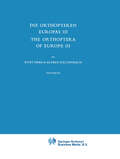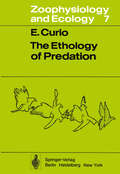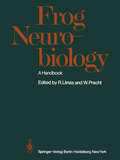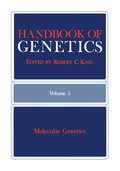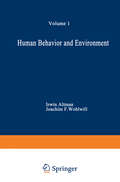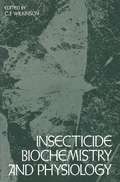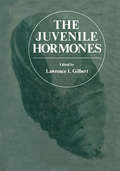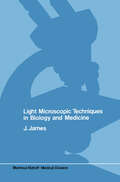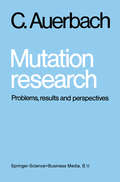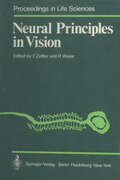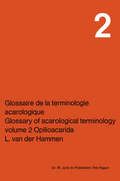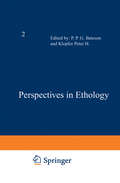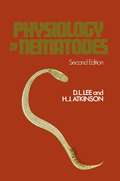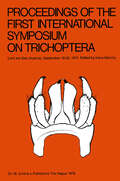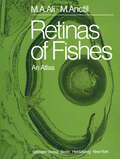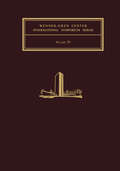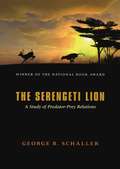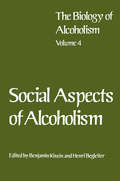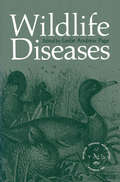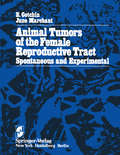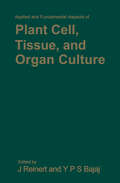- Table View
- List View
Die Orthopteren Europas III / The Orthoptera of Europe III: Volume III (Series Entomologica #12)
by A. Harz A. KaltenbachThe Ethology of Predation (Zoophysiology #7)
by E. CurioPredation is an ecological factor of almost universal importance for the biol ogist who aims at an understanding of the habits and structures of animals. Despite its pervasive nature opinions differ as to what predation really is. So far it has been defined only in negative terms; it is thought not to be par asitism, the other great process by which one organism harms another, nor filter-feeding, carrion-eating, or browsing. Accordingly, one could define predation as a process by which an animal spends some effort to locate a live prey and, in addition, spends another effort to mutilate or kill it. Ac cording to this usage of the word a nudibranch, for example, that feeds on hydroids would be a predator inasmuch as it needs some time to locate col onies of its prey which, after being located, scarcely demand more than eating, which differs little from browsing. From the definition just proposed consumption of the prey following its capture has been intentionally omit ted. Indeed, an animal may be disposed of without being eaten. Hence the biological significance of predation may be more than to maintain nutrition al homeostasis. In fact, predation may have something in common with the more direct forms of competition, a facet that will be only cursorily touched upon in this book.
Frog Neurobiology: A Handbook
by R. Llinas W. PrechtIn review, the amount of information available on the morphological and func tional properties of the frog nervous system is very extensive indeed and in certain areas is the only available source of information in vertebrates. Further more, much of the now classical knowledge in neurobiology was originally ob tained and elaborated in depth in this vertebrate. To cite only a few examples, studies of nerve conduction, neuromuscular transmission, neuronal integration, sense organs, development, and locomotion have been developed with great detail in the frog and in conjunction provide the most complete holistic descrip tion of any nervous system. Added to the above considerations, the ease with which these animals may be maintained (both as adults and during development) and the advantage of their lower cost as compared with other vertebrate forms make the frog one of the most important laboratory animals in neurobiology. With these thoughts in mind, we decided to compile this volume. Our goal in doing so was to assemble as much as possible of the information available on frog neurobiology and to have the different topics covered by authorities in each of the fields represented. To keep the handbook restricted to one volume, we found it necessary to omit the large field of amphibian muscle neurobiology, which has already been summarized in various other publications.
Handbook of Genetics: Volume 5: Molecular Genetics
by Robert KingMany modern geneticists attempt to elucidate the molecular basis of phenotype by utilizing a battery of techniques derived from physical chemistry on subcellular components isolated from various species of organisms. Volume 5 of the Handbook of Genetics provides explanations of the advantages and shortcomings of some of these revolutionary tech niques, and the nonspecialist is alerted to key research papers, reviews, and reference works. Much of the text deals with the structure and func tioning of the molecules bearing genetic information which reside in the nucleus and with the processing of this information by the ribosomes resid ing in the cytoplasm of eukaryotic cells. The mitochondria, which also live in the cytoplasm of the cells of all eukaryotes, now appear to be separate little creatures. These, as Lynn Margulis pointed out in Volume 1, are the colonial posterity of migrant prokaryotes, probably primitive bacteria that swam into the ancestral precursors of all eukaryotic cells and remained as symbionts. They have maintained themselves and their ways ever since, replicating their own DNA and transcribing an RNA quite different from that of their hosts. In a similar manner, the chloroplasts in all plants are self-replicating organelles presumably derived from the blue-green algae, with their own nucleic acids and ribosomes. Four chapters are devoted to the nucleic acids and the ribosomal components of both classes of these semi-independent lodgers. Finally, data from various sources on genetic variants of enzymes are tabulated for ready reference, and an evaluation of this information is attempted.
Human Behavior and Environment: Advances in Theory and Research. Volume 1
by Irwin Altman Joachim F. WohlwillThis is the first in a series of volumes concerned with research encompassed by the rather broad term "environment and behavior. " The goal of the series is to begin the process of integration of knowledge on environmental and behavioral topics so that researchers and professionals can have material from diverse sources accessible in a single publication. The field of environment and behavior is broad and interdiscipli nary, with researchers drawn from a variety of traditional disciplines such as psychology, sociology, anthropology, geography, and other social and behavioral sciences, and from the biological and life sciences of medicine, psychiatry, biology, and ethology. The interdis ciplinary quality of the field is also reflected in the extensive involve ment of environmental professionals from architecture, urban plan ning, landscape architecture, interior design, and other fields such as recreation and natural resources, to name just a few. At present, the field has a somewhat chaotic flavor, with research being carried out by a variety of scholars who publish in a multitude of outlets. Many researchers and practitioners are unaware of the state of knowledge regarding a specific topic because of the unavailability of integrated reference materials. There are only a handful of books dealing with environment and behavior, most of them unintegrated collections of readings, with only an occasional systematic analysis of some facet of the field.
Insecticide Biochemistry and Physiology
by WilkinsonOnly four short decades ago, the control of insect pests by means of chemicals was in its early infancy. The pioneers in the area consisted largely of a group of dedicated applied entomologists working to the best of their abilities with a very limited arsenal of chemicals that included inorganics (arsenicals, fluorides, etc.), some botanicals (nicotine), and a few synthetic organics (dinitro-o-cresol, organothiocyanates). Much of the early research was devoted to solving practical problems associated with the formulation and application of the few existing materials, and although the discovery of new types of insecticidal chemicals was undoubtedly a pipe dream in the minds of some, little or no basic research effort was expended in this direction. The discovery of the insecticidal properties of DDT by Paul Miiller in 1939 has to be viewed as the event which marked the birth of modern insecticide chemistry and which has served as the cornerstone for its subse quent developement. DDT clearly demonstrated for the first time the dramatic potential of synthetic organic chemicals for insect control and provided the initial stimulus which has caused insecticide chemistry to become a field not only of immense agricultural and public health importance but also one that has had remarkable and unforseeable repercussions in broad areas of the physical, biological, and social sciences. Indeed, there can be few other synthetic chemicals which will be judged in history to have had such a broad and telling impact on mankind as has DDT.
The Juvenile Hormones
by L. GilbertThe juvenile hormones of insects are unique molecules in terms of their chemical nature (methyl esters of sesquiterpene epoxides) and action (both as modulators of morphogenesis during the larval life of insects and as a gonadotropic agent in many female adults). Although a symposium dedicated to the chemistry, metabolism and effects of juvenile hormone at a number of levels would be merited on the basis of its interest to the chemist, physiologist, endo crinologist, developmental biologist and entomologist, the juvenile hormones are special in the sense that juvenile hormone mimics (juvenoids, insect growth regulators, analogs) are currently being utilized to control various insec. t pests. Indeed, a number of commercial firms are currently developing new compounds with juven ile hormone activity that might possess a narrow spectrum of acti vity and which would be relatively biodegradable. Thus, a symposium on the juvenile hormones is also merited on a practical basis since juvenoids are already becoming constituents of our environment and it is apparent that in order to design effective mimics of the natural juvenile hormones, o~e should understand the means by which juvenile hormone elicits its effects. As will become evident to the reader, the great majority of data presented at this symposium have not been published previously and the symposium itself was organized along natural divisions dealing with the chemistry, metaoolism and multi-level modes of action of the juvenile hormones. Special lectures were presented by Professors C. M. Williams, B. W. O'Malley and W. S.
Light microscopic techniques in biology and medicine
by J. JamesUp to about twenty-five years ago, virtually the entire field of microscopy could be overseen and even practized by any active research worker. The rapid evolution which microscopy in its broadest sense has since undergone and which has contributed greatly to our insight in many fields of biological science and medicine has, however, lead to a progressive specialisation. Both experienced investigators in clinical and biological laboratories and post graduate students, confronted with a limited number of microscopic tech niques in their daily research work, have increasing difficulty in keeping (or obtaining) a general idea of the many time-honoured and new possibilities which microscopy has to offer. This book has been written with the aim of presenting general informa tion on light microscopic techniques, at a level somewhere in between booklets like those provided by microscope manufacturers (which are often too much focussed on the production program of a particular make) and very advanced treatises with a thorough mathematical treatment of all phenomena concerned. The physically oriented texts moreover often do not sufficiently take into account the practical situation in a medical or biolog ical laboratory; on the other hand, the value of really understanding what one is doing in using a microscopic technique is often underestimated. At tempt has been made, therefore, to present sufficient background informa tion necessary for a rational application of the different microscopical tech niques in their mutual relationship.
Mutation research: Problems, results and perspectives
by Charlotte AuerbachThis book is intended for the senior undergraduate (Honours student) in genetics, and for the postgraduate who wants a survey of the whole field or information on a special area within it. In order to cater for readers with such different requirements, I have made the list of references unusually large for a textbook. It includes classical papers as well as very recent ones (to the end of 1974); reviews as well as specialized articles; elementary expositions from Scientific American as well as highly technical papers from journals on genetics and molecular biology. In areas of active research, I have given preference to the latest references, which will lead the reader to earlier ones. In addition to the references at the end of each chapter, a bibliography at the end of the book lists relevant books and general reviews. Apart from the first chapter, the book is not written as a history of mutation research; but throughout I have tried to emphasize the continuity of the problems, concepts and ideas. The reader will find many examples of this. Muller's once famous and then almost forgotten classification of genes by their action has now been given biochemical reality by studies of gene action in vitro. The problem of whether mutations can arise in non-replicating genomes is one of the oldest in mutation research; yet an unequivocal solution was obtained only recently with bacteriophage.
Neural Principles in Vision (Proceedings in Life Sciences)
by D. L. AlkonScientific investigation of the retina began with extensive studies of its anatomical structure. The selective staining of neurons achieved by the Golgi method has led to a comprehensive picture of the architecture of the tissue in terms of its individ ual elements. Cajal, in particular, used this tech nique to reveal the fundamentals of retinal struc ture. In the studies that followed, selective stain ing method continued to be decisive in the analysis of neuroanatomy, and in recent years these techniques have been complemented by electron microscopy. The complexity of retinal structure that has been revealed demands a functional explanation, and elec trophysiology attempts to provide it. But functional analysis, like anatomy, must ultimately be based on the single cell. It is only by using dyes to mark the recording site that one can identify the cells involved. When this succeeds, as it has recently, one can actually fit functional events into the ana tomical framework. With these advances, our strate gies and tactics toward an understanding of the structure and function of the retina have moved in to a new phase.
Perspectives in Ethology: Volume 2 (Perspectives in Ethology)
by P. BatesonIn the preface to the first volume of this series we set out our aims, which were to encourage fresh perspectives in ethology and provide a forum for new ideas. We still feel that in the perfectly proper search for high stan dards of evidence, methodology has tended to remain the master rather than the servant of most aspects of ethological work. It is easy for us all to forget that the kinds of data we collect are largely determined by the kinds of questions we ask. Even an ethologist with the professed goal of providing a straightforward account of behavior must incorporate into his or her descriptions a great many assumptions about the organization of that be havior. Inevitably some facets of what went on will have been selected at the expense of others. This is sometimes done, for example, in the service of a theory that the fundamental unit for description is the fixed action pattern. Our point is not that constraints on the collection of data are bad but that the theory which gives rise to the selection of evidence should not be neglected. In the first volume, the choice of topics and authors was based upon our views about the exciting or developing issues in ethology. This volume represents a more opportunistic approach: the articles were selected from among the many offered to us as best conforming to our aims. Neverthe less, certain themes do emerge.
Proceedings of the First International Symposium on Trichoptera: Lunz am See (Austria), September 16–20, 1974
by H. MalickyIn past years there have been several unsuccessful attempts to arrange a symposium on Trichoptera. Letters from fellow workers suggested that now might be an appropriate time, and that a symposium should be held in Lunz. Today it is clear that large congresses are losing their value because of the difficulty of attending all relevant lectures and of finding colleagues. In consequence, small symposia for specialist groups are becoming increasingly important. As I felt that the success of such a symposium must depend on the suggestions from its potential members, I sent out in April 1973, together with a first circular, a questionnaire, asking for opinions on time and length of the symposium, numbers of participants, types of communication, interests within Trichopterology, and lan guages which should be used. The majority of answers suggested the following: The number of participants should be between 20 and 50, and the duration, excluding excursions, should be three to five days; main interests were in ecology and systematics, but there were also interests in physiology, behaviour, zoogeography, morphology, cytotaxonomy and evolution. There was a clear preference for local excursions. Languages should be English, French and German, with a preference for English. The symposium should consist of both formal papers and informal progress reports, with adequate time for discussion. The arrangements have therefore been based on these results.
Retinas of Fishes: An Atlas
by Mohamed A. Ali Michel AnctilA considerable amount of information on the retinal morphology in fishes has been accumulating during the past century. Among the vertebrates, fishes are a highly successful group, both in number of species and in the adaptive radiation of forms. For instance, 415 teleost families are now recognised (GREENWOOD, ROSEN, WEITZMANN and MYERS, 1966), and the 20,000 odd fish species mentioned in text-books have been by far out numbered. The fish retina also shows considerable variations, in conformity with the extreme morphological diversification reached by piscine forms, in colonising all conceivable aquatic habitats and developing a wide spectrum of life habits. We intend to illustrate this in the present Atlas, a collection of short texts and photomicrographs of the retina from about one hundred fish families. This Atlas is intended also to fulfil other purposes. One of them is to present in a phylogenetic order the rather scattered data on fish retinal structure, with appropriate illustrative material; another is to assist the visual physiologist or biochemist in his search for a retina with particular morpholog ical features compatible with his specific requirements. In other words, what we aim at is a ready pool of information for laymen, students, and specialists of varied interests. The material used for this Atlas comes from various sources.
Sensory Functions of the Skin in Primates: With Special Reference to Man
by Yngve ZottermanSensory Functions of the Skin in Primates: With Special Reference to Man deals with sensory functions of the skin in primates, particularly humans. The discussions are organized around three themes: mechanoreception, thermoception, and nociception.Comprised of 43 chapters, this volume begins with a detailed treatment of the natural and paranatural stimulation of sensory receptors, followed by an analysis of a theory of sympathetic-sensory coupling. The reader is then introduced to the "receptripse", the desmosome-like lamellar-axonal junction subserving mechano-electric transduction and inducing the sympathetic actions on the pacinian sensor. Subsequent chapters focus on differences in timing of corticocuneate and corticogracile actions; organization and neuronal morphology of the spinocervical tract; skin mechanoreceptors in the human hand; and cellular mechanisms in the parietal cortex in alert monkeys. The book also examines the response of central trigeminal neurons to cutaneous thermal stimulation and the role of thermoreceptors in thermoregulation. This monograph will be of interest to specialists in fields ranging from anatomy and biology to physiology and neurophysiology.
The Serengeti Lion: A Study of Predator-Prey Relations (Wildlife Behavior and Ecology series)
by George B. SchallerBased on three years of study in the Serengeti National Park, George B. Schaller’s The Serengeti Lion describes the vast impact of the lion and other predators on the vast herds of wildebeest, zebra, and gazelle for which the area is famous. The most comprehensive book available on the lion, this classic work includes the author’s findings on all aspects of lion behavior, including its social system, population dynamics, hunting behavior, and predation patterns. “If you have only enough time to read one book about field biology, this is the one I recommend.”—Edward O. Wilson, Science “This book conveys not only the fascination of its particular study of lion behavior but the drama and wonder and beauty of the intimate interdependence of all living things.”—Saturday Review “This is an important book, not just for its valuable information on lions, but for its broad, open, and intelligent approach to problems that cut across the fields of behavior, populations, ecology, wildlife management, evolution, anthropology, and comparative biology.”—Richard G. Van Gelder, Bioscience
The Serengeti Lion: A Study of Predator-Prey Relations (Wildlife Behavior and Ecology series)
by George B. SchallerBased on three years of study in the Serengeti National Park, George B. Schaller’s The Serengeti Lion describes the vast impact of the lion and other predators on the vast herds of wildebeest, zebra, and gazelle for which the area is famous. The most comprehensive book available on the lion, this classic work includes the author’s findings on all aspects of lion behavior, including its social system, population dynamics, hunting behavior, and predation patterns. “If you have only enough time to read one book about field biology, this is the one I recommend.”—Edward O. Wilson, Science “This book conveys not only the fascination of its particular study of lion behavior but the drama and wonder and beauty of the intimate interdependence of all living things.”—Saturday Review “This is an important book, not just for its valuable information on lions, but for its broad, open, and intelligent approach to problems that cut across the fields of behavior, populations, ecology, wildlife management, evolution, anthropology, and comparative biology.”—Richard G. Van Gelder, Bioscience
Social Aspects of Alcoholism
by Benjamin Kissin Henri BegleiterThe first three volumes of this series have dealt with materials which generally justify the title, The Biology of Alcoholism. This is only remotely true of the present volume, Social Aspects of Alcoholism, or of the final volume to come, Treatment and Rehabilitation. Except for small portions of the treatment section which involve pharmacotherapy, much of these last two volumes deals with the psychological aspects of alcoholism and still more with the social. It is interesting to review the evolution of this new pattern over the past seven years, a pattern which, had it existed initially, would have resulted, if not in a dif ferent format, at least in a different title. Our initial selection of areas to be covered was influenced by our desire to present as "hard" data as possible, in an attempt to lend a greater aura of scientific rigor to a field which was generally considered as "soft. " When we completed our review of this material in volumes 1-3, we recognized that what we might have gained in rigor, we had more than lost in completeness. These volumes presented a picture of a biological disease syndrome for which the remedies and preventive measures were presumably also biological. And yet, most workers in the field readily accept the significant contributions of psychological and social factors to the pathogenesis and treatment of alcoholism.
The Stationary Ark (El\libro De Bolsillo Ser.)
by Gerald Durrell‘What we tried to do in Jersey is create a new sort of zoo. I think we have succeeded.’ In this important book Gerald Durrell describes his battles to create his vision of a new sort of zoo at Jersey with descriptions of his successes and failures with a liberal sprinkling of zoo animal tales on the way. Much of Gerald Durrell's long-standing basic captive breeding and conservation vision, which may, in a new century, seem almost obvious, is set out here along with prophecies - just one almost throwaway instance: ‘In our next step, we plan to form the Trust into a kind of mini-university of wildlife husbandry and breeding’.
Vet in Harness
by James HerriotThe Yorkshire dales have never seemed more beautiful for James - now he has a lovely wife by his side, a partner's plate on the gate and the usual menagerie of farm animals, pets and owners demanding his constant attention and teaching him a few lessons along the way. All of the old Darrowby friends are on top form - Siegfried thrashes round the practice, Tristan occasionally buckles down for finals and James is signed up for a local cricket team.From the author whose books inspired the BBC series All Creatures Great and Small, Vet in Harness is the fourth volume of James Herriot's classic memoirs; a book for all those who find laughter and joy in animals, and who know and understand the magic and beauty of Britain’s wild places.
Wildlife Diseases
by Leslie PageThe broad spectrum of topics covered in the nine symposia and four open-paper sessions of the Third Inter national Wildlife Disease Conference comprise a remarkable collection of ideas and current research information on diseases of wildlife. The term "wildlife" is broad in itself and is interpreted by the Conference sponsor, The Wildlife Disease Association, to mean all free-living vertebrate and invertebrate members of the animal kingdom. The Conference's invitational symposia brought to Munich an array of wildlife specialists from around the world who addressed major problems affecting the under standing and control of diseases of wildlife. The open paper sessions attracted many well-known scientists with detailed data from their specialized studies. Over 100 participants were present to hear 84 scientific papers. The Wildlife Disease Association and the Conference editors, through their publisher, are pleased to offer this compilation of presentations as a Conference Pro ceedings. This volume will be an important data source for the study of diseases of wildlife by students, specialists, and general biologists everywhere. WDA President W. G. Winkler expresses the Associa tion's gratitude to the Conference Chairman, Prof. Dr. H.
Acid Proteases: Structure, Function, and Biology (Advances in Experimental Medicine and Biology #95)
by Jordan TangIn the past ten years, a number of proceedings of symposia on the structure and function of proteolytic enzymes have been pub lished. Their coverage of acid proteases has been limited, mainly due to the lack of significant new information on the structure of these enzymes. In the last four years, however, the primary and tertiary structures of a number of acid proteases have been deter mined, prompting the need to discuss the meanings of the old data and the possibilities for new experimentations. It was for this purpose that the "Conference on Acid Proteases: Structure, Function, and Biology" was organized. It took place at the University of Oklahoma on November 21-24, 1976. This book is a collection of the main lectures delivered at the Conference. Acid Proteases, by definition refers to a group of proteases having an optimal pH in acidic solutions. The classic examples are pepsin and chymosin. Some catalytic features are obviously shared by these proteases, most notably, their inhibition by pepstatin. The use of active center-directed inactivators such as diazoacetyl norleucine methyl ester and 1,2-epoxy-3-(p-nitrophenoxy)propane has shown that two catalytic aspartyl residues are present in most of these enzymes. These apparent cornmon features have prompted the suggestion by several investigators to name this group of enzymes "aspartyl proteases" or "carboxyl proteases".
Animal Tumors of the Female Reproductive Tract: Spontaneous and Experimental
by E. Cotchin J. MarchantThe chapters which comprise this book were prepared as part of a medical text, Pathology of the Female Genital Tract, which is intended for the obstetrician, gynecologist, and medical pathologist. In that context, we were con cerned to bring out the importance of the study of tumors of the female reproductive tract of animals, both as show ing the variety of spontaneous neoplasms that might affect the tract and as providing tumors capable of experimental reproduction. These chapters are published separately, since they contain information which may appeal to a range of readers who might not necessarily wish to acquire the full medical text-for example, to veterinary and comparative pathologists, cancer research workers, research workers in gynecology, experimental pathologists and endocrinologists, and possibly to others using animals in experimental and pharmaceutical studies. The survey of spontaneous tumors of the female repro ductive tract is largely concerned with tumors of the ovaries and uterus of domesticated animals, but attention is also given to laboratory animals, wild animals, and animals in zoos. The spontaneous tumors are well worth studying, not only because of their obvious clinical impor tance to veterinarians, but also because they might provide a stimulus for epidemiologic, etiologic, biologic, and ther apeutic investigations that may elucidate some of the problems related to their counterparts in humans.
Applied and Fundamental Aspects of Plant Cell, Tissue, and Organ Culture
by Jakob Reinert Yashpal S. BajajProgress in the field of plant cell and tissue culture has made this area of research one of the most dynamic and promising not only in plant physiology, cell biology and genetics but also in agriculture, forestry, horticulture and industry. Studies with plant cell cultures clearly have bearing upon a variety of problems as yet unsolved in basic and applied research. This was the compelling reason for assembling such a comprehensive source of information to stimulate students, teachers, and research workers. This book comprises 34 articles on regeneration of plants, vegetative propagation and cloning; haploids; cytology, cytogenetics and plant breeding; protoplasts, somatic hybridization and genetic engineering; plant pathology; secondary products and a chapter on isoenzymes, radiobiology, and cryobiology of plant cells. Particular attention has been paid to modern , fast-growing and fascinating disciplines - e.g. the induction of haploids, somatic hybridization and genetic manipulation by protoplast culture, which possess an enormous potential for plant improvement.
